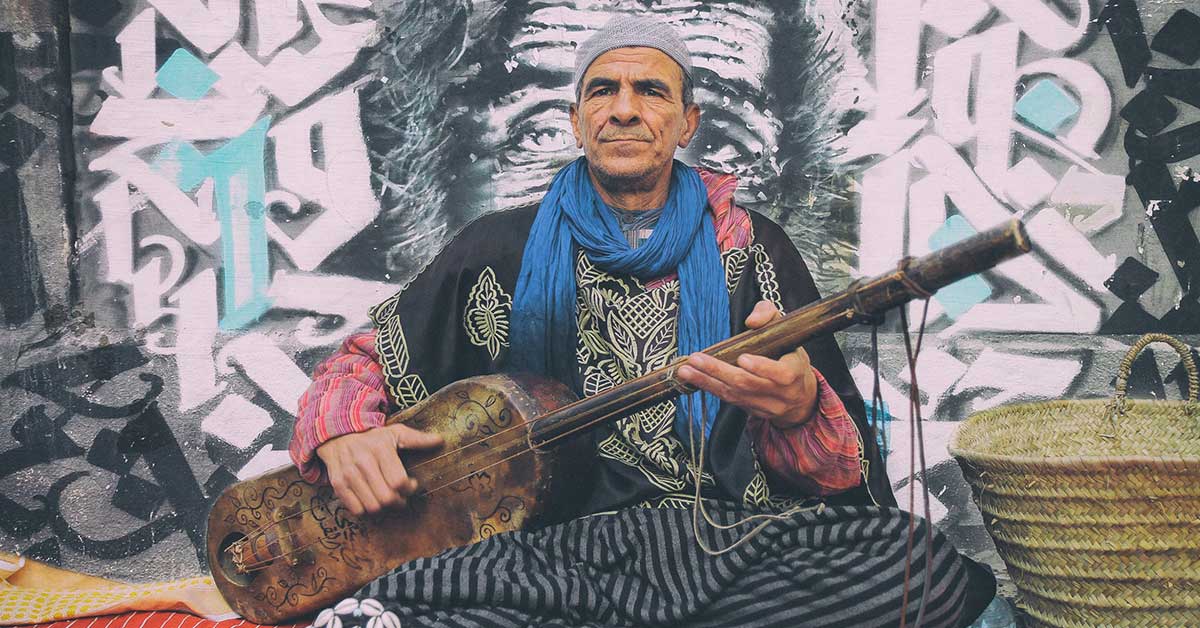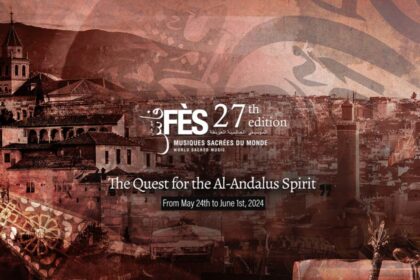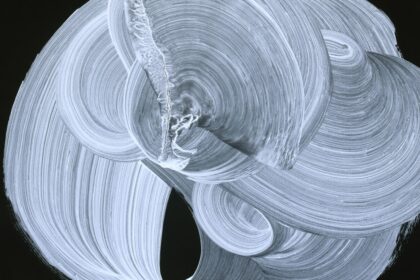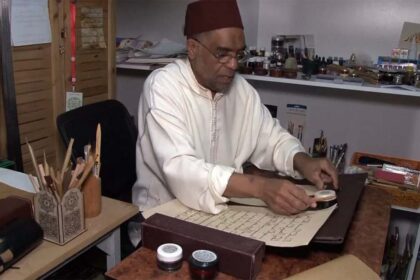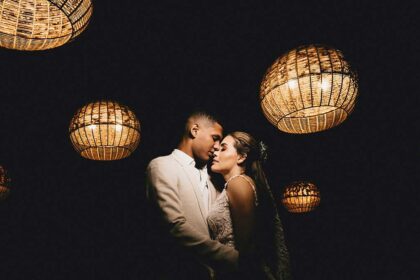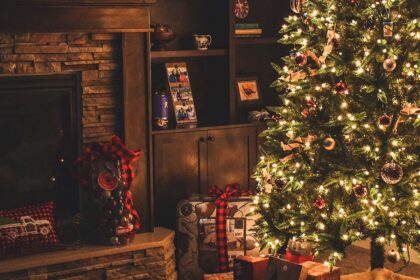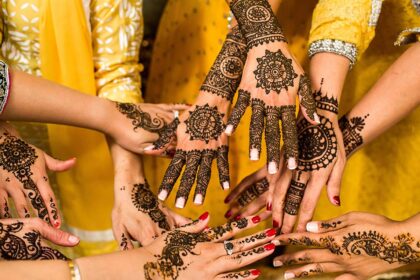The rich cultural diversity of Moroccan music has been nurtured through its history and its millennial traditions. With more than twenty-five different styles showcasing the richness of Morocco’s culture and echoing its present and past history. Depending on which region of the country you visit, you will undoubtedly hear Andalussi, Berber, Ayta, Chaabi, or Gnaoua sounds pervading the air.
Few countries in the world have a musical heritage as rich and ancient as that of Morocco. Moroccan music is as beautiful and enchanting as the country itself. Growing up in Morocco, I have always been proud of Moroccan music’s range, depth and diversity, expressed in many forms and through many instruments.
Few countries in the world have a musical heritage as rich and ancient as that of Morocco.
Music is indeed one of the richest parts of Morocco’s culture. Here is a list of Morocco’s most famous and rich musical genres from Andalussi and Malhoun in the north to the Sufi brotherhoods and Amazigh folk throughout the country and Hassani Sahraoui music in the very south.
Moroccan music: Ayta
When we talk about the popular oral tradition of Morocco, we are talking about expressive forms that have retained their originality over time. It is a very rich heritage which consists of an array of cultural manifestations as suggested by the odes, the anecdotes, the folk dances, the halgats, the songs, the ayouts (plural of Ayta).
Ayta occupies a large place in Morocco’s cultural and artistic heritage. The word itself means a call intended for a person in order to attract his attention. Artistically, it’s a means of musical oral expression originated from the countryside of Morocco, structured according to a logical sequence, beginning with a prelude, followed by several chapters, interspersed in turn by a chorus or refrain (transitional poetic verse which allows the passage from one sequence to another ), culminating in a dancing finale.
The art of Aita in Morocco contains seven main sections are: Marsawi, Hasbawi, Hawzi, Zaari, Khribgui, Jebli, Mellali. Ayta Art is about the realities of life — about the land, nature, wars, mountains, crises and, of course, it’s about love. In short, Aita music represents the heritage of Morocco.
source: aytart.comAmazigh folklore (Ahwach, Ahidous..)
The Berbers are some of the first habitants of Morocco. they developed, especially in the countryside, a very original musical style. This Moroccan music varies according to the region concerned. Each of Morocco’s three Berber regions has its own language and, in turn, their own Berber rhythms.
In addition to dialectal Arabic, there are three forms of Berber dialects spoken in Morocco: Tamazight in the West region of the Middle Atlas, Tachlhit in the South West region, and Tarifit in the North.
In most cases, Berber music is performed by popular artistic troupes composed of women and men, some singing in the dialect of the region and others performing dances punctuated to the rhythm according to string or percussion instruments such as the rebab, the lotar, which resembles the lute and the Bendir, a round drum, during moussems or other festivities such as weddings.
At the head of the troop, we always find a raïss in a white caftan and carrying on the side a dagger in an engraved case. This popular moroccan music has generated, in addition to singing, a way of dancing that has given rise to several forms of popular dances: ahwach dances and ahidous dances among others.
Ahwach, a Berber dance, collective and traditional, widespread in the High Atlas, this dance varies from region to region and from tribe to tribe, while keeping the same basics. This collective dance is performed to the rhythm of a traditional song: the tawala, orchestrated by a soloist. The ahwach is a joyful and convivial dance. It is a beautiful demonstration of Berber traditions in Morocco.
Ahidous, a millennial practice that is an integral part of our Moroccan artistic heritage. The Ahidous is a traditional dance practiced by the Berber tribes of the Atlas, in which women and men, attached, form undulating circles, accompanied by songs in Berber by rhythms of the bendir.
In addition to the famous Ahwach and Ahidous, Berber songs are collective songs of several types: tamawith, tariffareth, izlan, afardi, izran and asalaw.
Sufi
This beautiful mystical religions style of moroccan music can be traced back in its origins in the country of Morocco to the red city of Marrakech, the sufi music comes from sufism, it belongs to what it’s called tariqas or orders and some of the most famous tariqas in morocco are tariqa issawiya, boutchichiya, Hamadcha, Cherkaoua and Dar Dmana among others.
Sufism is the mystical side of Islam, and its history is traced to the very early days of the religion. The tariqas or Sufi brotherhoods get together, and music is an essential part of their spiritual tradition which seeks to reach a trance state to inspire a mystical fantasy. Sufi music is also strongly focused on poetry and as a form of devotions and worship.
Moroccan Sufi Music is a mystical, musical, cultural, and religious style that the Sufis believe it brings one spiritually closer to the Prophet Muhammad and Allah, typically performed with an oud (Arab lute), vocals, percussion, and sometimes with a reed flute called a “Ney,” and of course, the most essential element to it is that the poetic component produces a trance-like state.
Issawa
Issawa is what could be the most famous tari9a sufiya (a Sufi musical method or order), which means a religious form of Moroccan folklore, Meknes and Fez are the birthplaces of Issawa. Issawa was founded by Sidi Ben Aissa also called shaykh lkaml in the 15th century, the term Issawa or Aissawa comes from the founder’s name ben Aissa.
Issawa are Sufi brotherhoods, Moroccan folklore groups that sing Islamic songs but in special and rhythmic ways and are known for their spiritual music led by a “mqdm” head of the group. Bendir, taarija (percussion instruments), raita (small pipes) and n’far (large one-note trumpets) are some of its most used musical Instruments.
A “Issawa” night is a must on your next visit to the cultural and spiritual capital Fes. There are many riads in the old medina of the city that offer musical Issawa nights that would leave you wanting more.
Gnaoua
Gnaoua music, listed on December 12, 2019 in the intangible heritage of Unesco, is a tradition perpetuated in Morocco by the descendants of former slaves from sub-Saharan Africa. Combining African rituals and worship of saints venerated by local populations.
Gnaoua music was widely popularized by the Gnaoua Festival of Essaouira that was created in 1997 in the city of Essaouira in southern Morocco. For its part, Gnawa music is practiced by a religious brotherhood. The moroccan music of the gnaoua has a very particular rhythm, a mixture of African and Arab-Berber rhythms. The dancers perform impressive acrobatic figures inspired by Moroccan melhoun.
Gnawa music is definitely one of the most characteristic music of the Moroccan heritage with its beautiful unique rhythms, its sounds, colors, outfits, dances but also its rituals and traditions.
Gnawas use 3 main musical instruments: The Guembri, an instrument with chords, is the main instrument of a gnaoua group. It is the instrument of the maalem. The maâlem or master musician is also the singer of the group. The qraqebs or karkabous are percussion instruments where the sound produced comes directly from the material of the instrument (metal). And finally the tbel, the tbel is a drum and there are often 2 tbel players in a Gnaoua music group.
Andaloussi
Known formerly under the name of “musiqa Al Ala, موسيقى الآلة” translated to “instrumental music” to differentiate it from vocal music, of a religious nature, where the use of musical instruments is forbidden, with the exception of those used for show the rhythm, this heritage is today commonly called “at-Tarab al-Andaloussi,” or “al-Musiqa al-Andaloussia,” meaning Andalusian music.
Andalusian moroccan music is the main musical genre in Fes and Tetouan, composed of a repertoire organized into instrumental openings, songs of poems and improvised choruses, according to a musical system: Nawba. It is a classical music inspired by the songs of religious poems, it includes individual or collective songs like Moual. There are various subgenres of Andalousian moroccan music such as Gharnate, consisting of a mandolin and lute and can be heard in north of morocco in the cities of Tangiers and Tetouan.
Imported to North Africa by the Arabs expelled from Spain from the 11th century, As its name suggests, it contributed to enriching the Moroccan musical heritage, thanks to an oriental mixture of Arab, Berber and Iberian artistic data.
This Moroccan music is an elitist musical genre, often reserved for the celebrations of notables. The repertoire of the musicians, dressed in white djellabas, consists of several noubas, kinds of instrumental and vocal suites. Each piece is led by a soloist and played, with the support of songs, by the whole orchestra.
Chaabi
A highlight of Morocco’s traditional musical heritage, one of the most popular in Morocco, “Chabbi” meaning popular in Arabic, is indeed the most popular music listened to in Morocco. made its appearance thanks to the moussems celebrated in the four corners of the country.
The chaâbi nowadays is a moroccan music that is frequently found in weddings and this style is often associated with the party. The use of popular language and the creation of new rhythms have made this style an essential complement to dance.
The instrumentation of the Moroccan chaâbi can be varied: bendir, derbouka, violin, lute or gembri, and since the technological innovation, the electric guitar and the keyboard have appeared.
During musical performances, Moroccan women dance by swaying their hips, sweeping their hair and tapping their feet on the ground or on a metal sound box, a dance called in moroccan dialect derdigue. This specifically Moroccan dance is not found in any Arab-Muslim country. The derdigue would either be a vestige of Arab-Andalusian Spain found in Flamenco or (like hair sweeping) from trance ceremonies.
Nowadays, the artists of urban Châabi are more and more numerous and of different artistic quality, and among which we find: Abdelaziz Stati, Tahour, Daoudi, Daoudia, Haj Moughit, Saïd Sinhaj and Abidat Rma.
Melhoun
True poetic art, A heritage of inestimable value, Melhoum meaning “the melodic poem”, is a form of traditional Moroccan music that dates back to the fifteenth century originating from the region of the Tafilalet oasis and the zawias in southern Morocco to then have spread to the rest of the country .
Originally, malhun started as a pure literary creation with poems that sing of daily life in the medinas, sung words, a poetic genre today known in Morocco under the name of “qasida”.
This form is today accompanied by instruments such as the “oud” (from the family of plucked string instruments) or the “bendir” (percussion instrument). It has been influenced through the ages by the rhythms of Andalusian moroccan music and popular songs which gave birth to Melhoun as we know it today.
Sahraoui Music
In the Saharaoui oral tradition, music and poetry have always been inextricably intertwined, allowing for a greater understanding and transmission of poetry by combining classical Arabic poetry, which consists of at least seven verses with a single rhyme, a musical form played in a specific defined order starting from when the lute player begins his melody
This type of song, called “Al Haoul” in Hassaniya language, frequently stimulates as much fear of the Saharan expanse as it does solitude.
Hassani poetry, an important part of Sahraoui culture, comes from the Amazigh/berber and arabic culture as much as the Mauritanian griots and is particularly inspired by the daily life of the desert. The poetry equally expresses the hopes and fears, traditions and the relationship between men and women. Religious faith is also a source of inspiration with hadiths and Koranic verses serving as a basis for poems.
The instruments employed, like the poetry they accompany, are the result of cultural hybridization between the Sahara and Sub-Saharan Africa. The Saharan instrumentalists tend to reside in two areas in particular: Noun and Saqua el Hamra.
It is also from Noun that the “guedra”, a famous Saharawi dance is native. As for Saquïa el Hamra, it has always been a rather mythical place and destination of the “Iggaouen”, the stray griots coming from Mauritania.
Some of the most famous Sahraoui moroccan music instruments are: the “tbal” used indifferently in the two Saharan parts of Noun and Saquia el Hamra. And the “Tidinite ” is a four string lute reserved for men, a privileged instrument of the Mauritanian griots and strongly reminiscent of the “guembri” gnawa.
Moroccan jewish music
The Jews of Morocco have always been part of the socio-economic landscape of the Kingdom. Without abandoning the Jewish heritage which has enriched the Arab-Muslim heritage. Making the Moroccan identity a base of several cultures and religions.
Moroccan Jews preserved religious and secular musical traditions, improvised upon them and popularized them. Frequently performing alongside Muslims, they contributed to the development of an authentic Moroccan music scene.







